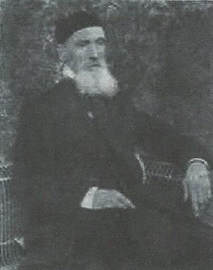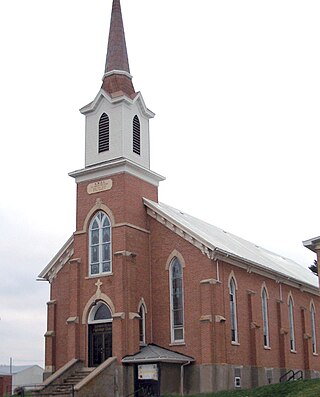
William Butterfield was a British Gothic Revival architect and associated with the Oxford Movement. He is noted for his use of polychromy.

Sir George Gilbert Scott, largely known as Sir Gilbert Scott, was a prolific English Gothic Revival architect, chiefly associated with the design, building and renovation of churches and cathedrals, although he started his career as a leading designer of workhouses. Over 800 buildings were designed or altered by him.

Lindfield is a village and civil parish in the Mid Sussex District of West Sussex, England. The parish lies 1 mile (2 km) to the north-east of Haywards Heath, and stands on the upper reaches of the River Ouse. The name 'Lindfield' means 'open land with lime trees.'
Thomas Plume was an English churchman and philanthropist, and founder of a library in Maldon, Essex which still exists. The Plume School in Maldon is named after him.
Clyro is a village and community in Radnorshire, Powys, Wales, with 781 inhabitants as of the 2011 UK Census. The nearest town is Hay-on-Wye, some 1.5 miles (2.4 km) to the south-east.

The Parish of Taney is a populous parish in the Church of Ireland, located in the Dundrum area of Dublin.

The Reverend Robert Willis was an English academic. He was the first Cambridge professor to win widespread recognition as a mechanical engineer, and first to set the scientific study of vowels on a respectable foundation. He is now best remembered for his extensive writings on architectural history, including many studies of mediaeval cathedrals and a four-volume treatise on the architecture of the University of Cambridge. He was described by Pevsner as "the greatest English architectural historian of the 19th century".
George Wilkins, D.D. (1785–1865) served as a priest in the Church of England and was Archdeacon of Nottingham.

All Saints Notting Hill is a Church of England parish church in Talbot Road, Notting Hill, London that is affiliated to the Anglo-Catholic Forward in Faith movement. The church is built in a Victorian Gothic Revival style with striking polychromatic decoration. For heritage purposes the church is a Grade II* listed building.
Norman Henry Tubbs was an Anglican bishop in the 20th century.

St Wilfrid's Church is an Anglican church in the town of Haywards Heath in the district of Mid Sussex, one of seven local government districts in the English county of West Sussex. It is Haywards Heath's parish church, and is the mother church to two of the town's four other Anglican churches. Designed in the Decorated Gothic style by George Frederick Bodley, it was built between 1863 and 1865 as the town began to grow rapidly, and stands in a prominent position on the highest ground in the area. English Heritage has listed it at Grade II* for its architectural and historical importance.

St Bartholomew's Church, Armley is a parish church in the Church of England in Armley, West Yorkshire. The church is one of two Church of England churches in Armley; the other being Christ Church. Worship at St Bartholomew's is firmly rooted in the Anglo-Catholic tradition of the Church of England with a solemn mass being celebrated weekly.
Henry John Rose was an English churchman, theologian of High Church views, and scholar who became archdeacon of Bedford.

Thomas Davis was a Church of England clergyman, author and hymn writer.
William Gresley was an English divine. He was a high churchman, who joined in popularising the Tractarian movement of 1833.

Sacred Heart-Saint Wenceslaus Church in Pine Creek, Wisconsin, referred to in Polish as Kościół Najświętszego Serca Pana Jezusa i Świętego Wacława, is a historic church of the Roman Catholic Diocese of La Crosse. It is known simply as Sacred Heart.

St Nicholas' Church is a Grade I listed parish church in the village of Berden, Essex, England.
Henry Jones Lanchester (1834–1914) F.R.I.B.A was an English architect and surveyor. Most of his building work was carried out in Greenwich and Hove.

The Church of St Luke, High Orchard, Gloucester, was a Church of England church built and endowed by the Reverend Samuel Lysons, rector of Rodmarton, who was also the first minister.

All Saints Church, Lindfield is a Grade II* listed Church of England church in Lindfield, West Sussex, England, built in the Middle Ages in the Early English style. The church is built of Sussex and Ardingly sandstone and dates mainly from the early 14th century. In the late 16th and early 17th centuries the church fell into decline and became almost derelict. It was fully restored in the mid-19th century, largely thanks to the efforts of the curate Reverend Francis Hill Sewell, a Cambridge graduate who remained the incumbent at Lindfield until his death in 1862.














